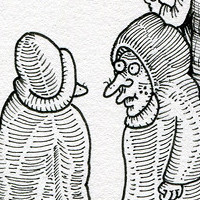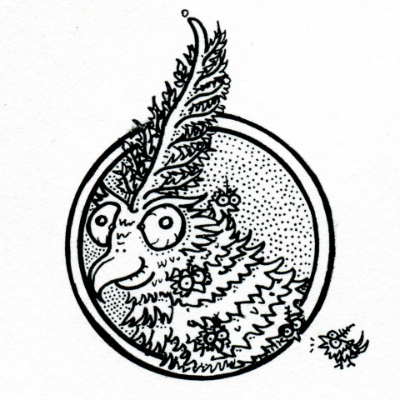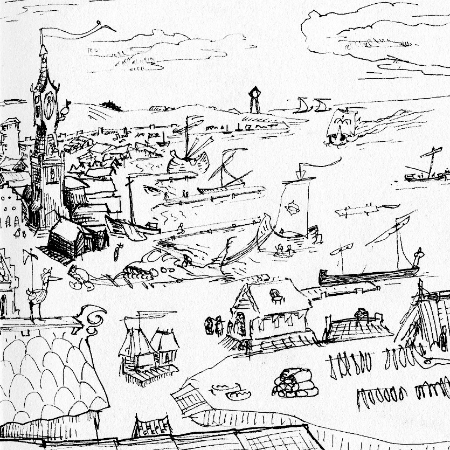
“Unstable!”, said the Kat.”
Den plaatselycken Byljuuvve inspekteert
eene gammele Kootery*
IN THE BROAD VALLEY of Zwalpdal† several rivers decided to come together and form a lake.
The folk living there mounted their houses on stilts and watched their orchards drown in a gentle deluge. The curious lake grew and expanded. It explored the curves and inclines of the valley until it had covered the land from slope to slope. It invited the rain to fall into it and grew ever so deep. Many kinds of fish found their home in this fresh aquatic realm; there was trout & bass & ducks & frogs.
There was Sproeihaack & Grootmuyl, Fontýnneslang & Kolcksteert‡. The locals abandoned their agricultural ways and spent their days living in and upon this new swirling body of water.
AFTER SEVERAL GENERATIONS, the lake -now broad and crystalline- fell in love with the heat of the Sun and wanted to get nearer to its warmth. The rain drops had taught the lake to soar, and soon a slow reverse rain began to fall upward. Hesitant at first, but then steadily and determined the skies filled up with glossy, shimmering clouds. The floating lake caught the spears of Heetesonne# and denied their heat to the inhabitants of the vale. Higher & higher the water ascended, journeying ever closer towards the sun.
MEANWHILE, THE LANDSCAPE BELOW was transformed into a vast bog; a muddy plain that stretched to the horizons. People now dwelled in the mud, among the carcasses of their ancestors’ orchards and the miserable descendants of the once shiny and silver-scaled maritime fauna.
Every year they race against the rot to plant and harvest, to scavenge what they can. But roots are suffocated and lungs are silted. Soaked, muddied, miserable from head-to-toe they remain in the mire, hoping that one day the lake shall return.
But it never will.
Notes
“The local Byljuuvve inspects a wonky Kootery” — in the illustration we see a local official making his rounds, and stopping by to watch a carpenter repair a fishing cabin.
Byljuuvve — meaning Bailiff; a street-level representative of regional authorities. The halberd is a rather symbolic weapon, representing the Byljuuvves final say in resolving disputes among the common folk.
From Dutch: ‘bijl’ (axe) and ‘baljuw’ (bailiff)
Kootery — a small multi-purpose cabin, to be used as storage rooms, workshops or even as a living space. Common in marshlands or river deltas.
From Dutch: ‘kot’, ‘koterij’ (cabin or animal-pen)
Zwalpdal — Wobble Valley; so called for its bumpy landscape.
From Dutch: ‘zwalpen’ (to wobble)
Sproeihaack — Sprayhook; a type of mollusk, not pictured.
Grootmuyl — Bigmouth; a type of fish known for its tendency to nibble and bite at everything, does not shy away from cannibalism, not pictured.
Fontýnneworm — Fountainworm; a moray eel-type of fish that sprays ‘fountains’ to tackle flying insects, the spraying of elaborate water streams is wonderful to behold.
Its spraying features heavily in mating rituals; display and bedazzlement are important here, as mates are chosen for life. A couple of Fontýnnewormen is pictured bottom left.
Kolcksteert — Swirltail; a relative to the afore mentioned Grootmuyl, but strictly herbivore. So called for tearing up/uprooting marine flora with its horned tail,
creating small whirlpools in the process. Pictured bottom right.
Spears of Heetesonne — folkloric name for sun-rays.
See also: Heetesonne in the Bosfables






